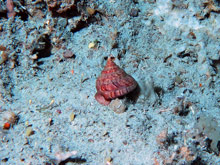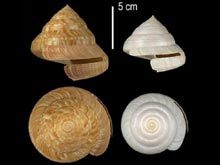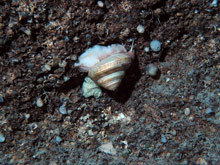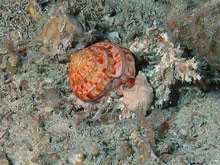Figure 1. The Midas Slit Shell. Bayerotrochus midas. Crawling along the underside of an overhanding rim of a rock wall at a depth of 1,400 ft. along the walls of Jordan Sinkhole, Portales Terrace, off the Florida Keys. Click image for larger view and image credit.
Well Worth the Wait, A Wealth of Specimens
November 19 , 2005
Jerry Harasewych, Ph. D.
Smithsonian Institution
Washington, DC
![]() View
video footage of scientist searching for the slit-shell snails. (Quicktime,
888 Kb.)
View
video footage of scientist searching for the slit-shell snails. (Quicktime,
888 Kb.)
![]() View
video footage of how scientist, uses a pipette to "milk," or extract
a thick white liquid, from the slit-shell snail, Perotrochus
amabilis. (Quicktime,
824 Kb.)
View
video footage of how scientist, uses a pipette to "milk," or extract
a thick white liquid, from the slit-shell snail, Perotrochus
amabilis. (Quicktime,
824 Kb.)
![]() View
video footage of scientist doing chemical analysis on the slit-shell
snail “milk”. (Quicktime, 1 Mb.)
View
video footage of scientist doing chemical analysis on the slit-shell
snail “milk”. (Quicktime, 1 Mb.)
For much of this cruise, I was delighted to observe incredibly rich habits teaming with splendid organisms from a wide variety of phyla. Few of these organisms, however, were snails, the animals that I came to study. In the northern, and deeper portions of the study area, we did collect several different snails that had become adapted to feeding on deep sea corals, among them the rare Pedicularia decussata, a relative of cowries and Flamingo Tongues encountered in shallower waters, and Coralliophila lactuca, a deep sea representative of a group of snails specialized to feed on corals. As we moved south, the dives became somewhat shallower and the bottoms had more hard ground and large rocky surfaces. Mollusks became more common. But it was not until the last day of diving, on the Portales Terrace off the Florida Keys, that we encountered classic slit shell habitat and animals in profusion.

Figure 2. The Lovely Slit Shell, Perotrochus amabilis inhabits a rubble strewn area between 850 and 700 ft. along Tennesee Bioherm 1, a mound that extends from the sea bottom at a depth of 1,000 ft to within 550 ft of the sea surface. Click image for larger view and image credit.
Nearly all of my previous experience in collecting slit shells from submersibles had been from the other side of the Gulf Stream, in the Bahamas, Bermuda and the islands of the Antilles. I was reassured to find similar patterns of zonation of genera by depth. The large, globular slit shells of the genus Bayerotrochus occur in the deepest portion of the range, generally on steep rocky walls encrusted with small sponges (Figure 1). The intermediate depths are occupied by members of the genus Perotrochus (Figure 2), generally the smallest of the slit shells.
They inhabit flatter areas strewn with rocky rubble. The shallowest living of the slit shells are usually the largest. Some members of the genus Entemnotrochus, characterized by a very deep slit, can reach ten or more inches in diameter, forming a cone nearly as high. The Adanson's Slit Shells, Entemnotrochus adansonianus, collected in this area (Figure 3) were small for the species. While the order was correct, the depth range was compressed off the Florida coast, with the top at 550 ft, and the bottom at 1,400 ft, compared to a range of 250 ft to 2500 ft in the Bahamas. A fourth species of slit shell, tentatively identified as Perotrochus charlestonensis (Figure 4) was also collected along the Portales Terrace, in intermediate depths, shallower that Bayerotrochus, but deeper than Perotrochus amabilis. It is the slit shells of the intermediate depths that are the most diverse as well as the most biogeographically complex.

Figure 4. Two specimens of the Charleston Slit Shell, Perotrochus charlestonensis, from the base of the Tennessee Bioherm 1. This species was previously known only from the Charleston Bump, an area due east of Charleston, South Carolina. The characteristic slit of this group of snails is shown clearly here. This is a natural feature of the shell that forms the anatomical midline of the snail's body. Click image for larger view and image credit.
The Portales Terrace appears to be an area in which two groups of Perotrochus co-occur. One group, characterized by Perotrochus amabilis, occurs in the Gulf of Mexico and along the eastern coast of the United States as far north as South Carolina. The other group, typified by the Bahamian Perotrochus lucaya and Perotrochus charlestonensis, occurs throughout the Bahamas and Caribbean Sea. The Gulf Stream is the boundary between the two groups, yet both co-occur beneath it. The samples collected during this cruise will provide much useful data when their DNA is extracted and analyzed. We will have a clearer picture of genetic interactions at boundaries and regions where species overlap.
Another unusual feature of slit shells is that they produce an opaque, milky secretion when they are disturbed. This secretion is produced by special glands, the hypobranchial glands on each side of the slit, and coats the shell. We have indirect evidence that this secretion may irritate potential predators such as crabs and fish, causing them to drop the slit shell. Each of the slit shells we collected on our dives was "milked" for its secretion, which was frozen and will be analyzed at the Smithsonian Marine Station. This expedition has provided a wealth of material for studies of evolution, population genetics, biogeography, and chemical ecology of deep sea snails.
Sign up for the Ocean Explorer E-mail Update List.


























